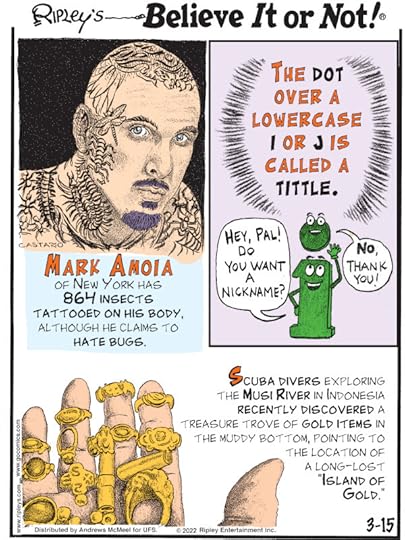Ripley Entertainment Inc.'s Blog, page 97
March 17, 2022
Metallica Facts That Strike A Power Chord
Featured in Ripley's Believe It or Not!

Over the past four decades, Metallica has become synonymous with the metal genre, selling more than 100 million records since their 1981 debut, racking up 18 Grammy nominations with nine wins, and touring the world in record-breaking fashion. Ride the lightning with us as we drop some heavy facts about Metallica’s journey from jam band to the biggest name in metal.
Lars Ulrich Moved From Denmark To California To Play Tennis.Before becoming one of music’s wealthiest drummers, Lars Ulrich had his sights set on achieving greatness via the family business — professional tennis. Both Ulrich’s father and grandfather were professional tennis players, with the elder Ulrich, Einer, being talented enough to represent Denmark in the Paris Olympic Games in 1924! The duo instilled their passion for the sport into the younger Ulrich, who moved from Denmark to Newport Beach, California, to train professionally in 1980, when he was only 16-years-old.
Upon arriving in California, Ulrich failed to make his school’s team. After that, he turned his attention to music.
Embed from Getty Imageswindow.gie=window.gie||function(c){(gie.q=gie.q||[]).push(c)};gie(function(){gie.widgets.load({id:'6zj7ADurTIxAvJRvQ0QJEA',sig:'IhB4Wj6ygzve9Ckc4pFwvQMq5sujtHgpQe0I9ix9oNo=',w:'594px',h:'592px',items:'1293631022',caption: true ,tld:'com',is360: false })});
First Impressions Were Not Good, And The Band Name Was Misspelled On Their First Album Feature.In May 1981, Ulrich placed an advertisement in a Los Angeles newspaper called The Recycler, seeking “other metal musicians to jam with Tygers of Pan Tang, Diamond Head, and Iron Maiden.” Guitarist James Hetfield responded to the ad but was unimpressed as Ulrich’s cymbals were cracked and kept falling off his drum kit.
Despite not having a full band to back him up, Ulrich requested a spot on Metal Blade Records’s Metal Massacre compilation album and invited Hetfield to join him on vocals and rhythm guitar. The move changed Hetfield’s tune, and the duo set out to round out their lineup.
Five months after meeting, they had recruited Dave Mustaine, and their first song, “Hit the Lights,” was featured on the compilation under the name Metallica — or “Mettallica” as it was listed on the record sleeve, much to the band’s chagrin.
James Hetfield Has A Guitar Made From An Early Rehearsal Space.
Did you know that Metal Blade Records listed @Metallica as “Mettallica” on that album? 🤔 pic.twitter.com/JFZkE8hFB6
— MᴇᴛᴀʟʟɪᴄA (@BookOfMetallicA) June 14, 2020
After relocating to the Bay Area, Metallica began practicing at 3132 Carlson Boulevard in El Cerrito, penning both “Ride the Lightning” and “Master of Puppets” in the garage. The location’s sentimental value held strong with the band, with Hetfield even hatching the idea to relocate it years later to be incorporated in their new rehearsal space. Though the owners demolished the garage before his plans could come to life, his friend did manage to keep eight pieces of wood during its demolition. Hetfield recruited guitar guru Ken Lawrence to craft a custom guitar, which Hetfield named Carl, out of the remnants of the musical landmark.
Metallica’s “Enter Sandman” Is One of the Most Iconic Walk-up Songs.
James Hetfield used some of the wood from the garage where “Ride the Lightning” & “Master of Puppets” were written, to build a new guitar! Meet “Carl”:#Metallica pic.twitter.com/winNXS5m0p
— MᴇᴛᴀʟʟɪᴄA (@BookOfMetallicA) April 9, 2018
From the time he joined the New York Yankees in 1999, baseball fans knew exactly what to expect when famed closer Mariano Rivera, a.k.a. The Sandman stepped out onto the pitch to “put bats to sleep” — Metallica’s “Enter Sandman” blasting through the speakers.
The song about a child’s nightmares and fears became one of baseball’s most famous traditions until Rivera’s retirement September 22, 2013. To show their appreciation, Metallica showed up to play the 1991 hit as his number was retired and even recorded a congratulatory message for Rivera’s induction into the Baseball Hall of Fame in 2019.
Despite being a fan of the men behind the music, Rivera didn’t choose the song for himself — or even necessarily like it, saying, “With all due respect to Metallica, I don’t listen to that kind of music.” The song was a marketing decision suggested by Yankee’s staff member Michael Luzzi, who saw that heavy metal made great walk-up songs based on how the crowd went wild for then-Padres’s pitcher Trevor Hoffman’s use of AC/DC’s “Hells Bells.”
Despite Metallica’s Lawsuit Against Napster, One Member Attended the Co-Founder’s Wedding.After hearing that their yet-to-be-released single “I Disappear” had been leaked via Napster, Metallica filed a $10 million suit against the peer-to-peer file-sharing platform, explaining in a press release that “it is sickening to know that our art is being traded like a commodity rather than the art that it is. From a business standpoint, this is about piracy — taking something that doesn’t belong to you. And that is morally and legally wrong. The trading of such information – whether it’s music, videos, photos, or whatever — is, in effect, trafficking in stolen goods.”
During this time, bassist Jason Newsted left the band, stating that they were more focused on the Napster lawsuit than making music.
Napster ended up settling the lawsuit in July 2001, at which time Ulrich shared that the band’s “beef hasn’t been with the concept of sharing music,” but rather that they had not been given a choice to participate.
Ulrich and Napster co-founder Sean Parker eventually buried the hatchet, with Ulrich even attending Parker’s wedding in 2013!
Metallica Has Played a Concert on Every Continent — Including Antarctica!Metallica has played more than 1,700 live concerts (and counting) throughout their career, including over 50 appearances in their home base of San Francisco.
On December 8, 2013, the band shipped themselves to Antarctica for an hour-long concert dubbed “Freeze ‘Em All,” setting a Guinness World Record for becoming the first band to play on all seven continents — in a single year, at that!
The band performed their greatest hits, including “Enter Sandman,” “For Whom the Bell Tolls,” “Nothing Else Matters,” and “One” for 120 scientists and winners from a Coca-Cola-sponsored fan competition.
Metallica Has Its Own Whiskey Brand, Crafted By Pulsing The Band’s Music Into The Barrel While It Ages.In 2017, Metallica enlisted master distiller Dave Pickerell (of Maker’s Mark fame) to help them craft a tasty beverage of their very own. Named for one of their songs, BLACKENED American Whiskey is put into black brandy casks for finishing — but not until they’ve been blasted with the brand’s trademarked BLACK NOISE sonic-enhancement process, during which Metallica pulses through the whiskey. Each batch gets a new playlist chosen by the band.
We hope their cover of Thin Lizzy’s cover of “Whiskey in a Jar” was included in that playlist!
Metallica’s First Album Cover Art Was Going to Feature a Toilet.After much dispute with their label, Metallica’s first album was renamed from “Metal Up Your A—” to “Kill ‘Em All.” The original artwork featured a hand holding a dagger coming out of a toilet. That didn’t fly with the label either, but it has become a popular band shirt.
Speaking of Toilets… A fully functioning Lars Ulrich–shaped toilet is heading to Ripley’s Believe It or Not! Copenhagen.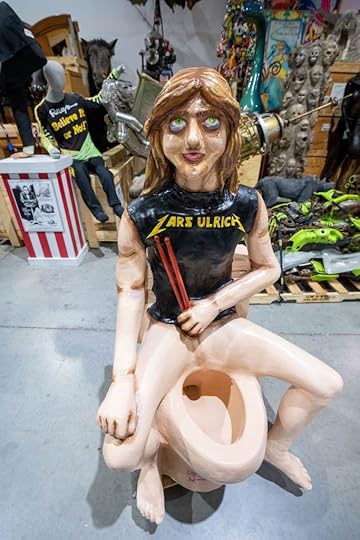
Sculpted Lars Ulrich Toilet created and donated to Ripley’s Believe It or Not! by Prince Midnight
Last year, Florida-based metal musician and quirky craftsman Prince Midnight constructed a fully functioning toilet sculpture in the likeness of ’80s-era Lars Ulrich — and we were lucky enough to get our dirty hands on it!
The sculpture, fashioned using natural clay and resin cast from his own feet and hands, is part of Midnight’s Hellmouth Plumbing Supply, a boutique bathroom venture consisting of toilet seats featuring classic metal album covers. Midnight used photos of Ulrich to inspire the facial mold and finished the whole thing off by running steel rebar from head to bowl with fiberglass batting.
While some may see a toilet shaped after themselves as an insult, Midnight made it very clear that the art piece is in honor of metal royalty, a throne for fans to worship on, if you will.
Midnight, a born metalhead, explained the tribute saying, “I could have painted a picture or made a traditional sculpture, but no one would have even noticed, and really, that’s not the kind of art and performance I do. The first band I ever loved was Metallica, the first record I became obsessed with, the first music I ever dove into, the concert I ever attended.”
If you’re still miffed about the Napster debacle, we’re sorry to say you will not be able to take your business out on the sculpture. Though it was briefly installed — and used — in the restroom of Brass Mug in Tampa, Florida, our Copenhagen museum will be showcasing it in a more, ahem, public forum.
When asked why he’d chosen Ulrich over other band members, Midnight replied Ulrich’s sitting position as the drummer made him the obvious choice for a toilet. “I could have done a urinal with James (Hetfield), but that’s not where the creative spirit was leading me.”
By Meghan Yani, contributor for Ripleys.com
EXPLORE THE ODD IN PERSON! Discover hundreds of strange and unusual artifacts and get hands-on with unbelievable interactives when you visit a Ripley’s Odditorium!The Magician Who Allegedly Made Battle Tanks Disappear
Featured in Ripley's Believe It or Not!

Among the chaos of WWII, a British magician claimed he could fool the Nazis by hiding tanks in plain sight and making armies invisible. But was he a hero or a fraud?
Stage magician Jasper Maskelyne came from a family that was well-versed with accomplishing the impossible. His father was a magician and inventor (though his invention of the paid toilet wouldn’t necessarily have been useful during war times) and his grandfather, John Nevil Maskelyne, invented the trick of human levitation and even founded the Occult Committee to investigate and expose fraudulent supernatural power claims.
Before the war broke out, Jasper was doing pretty well for himself, performing mostly sleight-of-hand card tricks in front of packed audiences in London. When the conflict of war started to affect ticket sales, he decided to join the Royal Engineers corps — a branch of the British army that focuses on providing technical support.
Mobilizing the World of MagicMaskelyne had a very specific goal in mind, though. He wanted to offer the army a chance to “mobilize the world of magic against Hitler” — an offer that was received with more than a bit of hesitation. Still, he was sent to Cairo as part of the Camouflage Experimental Unit made up of painters, sculptors, architects, and woodworkers. They were responsible for coming up with illusions to trick the Germans and help prisoners of war escape. And while typical war camouflage was mostly based on painted canvas and nets, Maskelyne had other ideas.
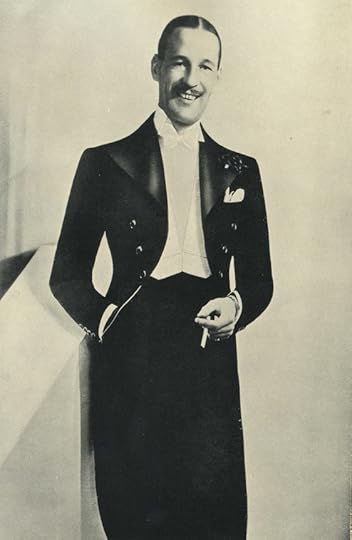
Jasper Maskelyne – Maskelyne’s Book of Magic. David McKay Company, 1937.
Like his sleight-of-hand tricks and magical illusions, this is where details of the story get a bit blurry. Maskelyne’s autobiography speaks of many magical achievements, but historical records are skeptical as to how many of the things he wrote about actually happened.
Maskelyne’s Tricks of MayhemThe two biggest “tricks” Maskelyne claimed to have designed were both hiding massive spaces. The story goes he built a fake Alexandria Harbor (using cardboard and mud) to protect the real one from bombings. This confused the planes, which ended up destroying the fake harbor and leaving the real Alexandria intact.
His next big magic trick, supposedly, made the Suez Canal disappear using an illusion created by flickering, swirling lights projected into the sky. But despite a prototype being built and tested, there’s no record that Maskelyne’s invisibility trick was the reason the Suez Canal didn’t get bombed.
Though these two major stunts still remain up for debate, many other potential illusions are far more credible.
Trucks or Tanks?Maskelyne is said to have helped Field Marshall Bernard Montgomery to reclaim the city of El Alamein as the first step to take back North Africa! To do so, Maskelyne used plywood and canvases to make trucks look like tanks and tanks look like trucks. This created the illusion of the tanks approaching the city from a different direction than they actually were.
He also suggested putting down imitation tank tracks marks in the wrong place in the desert to confuse the German forces. The illusion was completed with fake sounds and radio transmissions.

An inflatable dummy Sherman tank, one of many deceptions that Maskelyne claimed to have created.
There’s also a rumor that he invented inflatable tanks to fool planes, though there’s no proof these ever existed. Did the tricks work? Whether you believe in magic or not, Montgomery did win the battle of El Alamein.
It may be impossible to truly know all the details of what the Camouflage Experimental Unit actually achieved during the war. After all, records of wartime intelligence are kept sealed to avoid giving out secrets. Was Maskelyne’s contribution to the war effort really that magical? We might never know that either, but it doesn’t hurt to believe in the impossible!
By Diana Bocc, contributor for Ripleys.com
EXPLORE THE ODD IN PERSON! Discover hundreds of strange and unusual artifacts and get hands-on with unbelievable interactives when you visit a Ripley’s Odditorium!Source: The Magician Who Allegedly Made Battle Tanks Disappear
CARTOON 03-17-2022
March 16, 2022
Bearcats Smell Like… Buttered Popcorn?
Featured in Ripley's Believe It or Not!

Animals communicate through innovative, multi-sensory means, including sight, sound, and smell. As the American Scientist points out, we’ve known since ancient Greek times that male dogs are attracted to the scent of female dogs in heat. And Charles Butler hypothesized way back in 1623 that the smell of an injured bee incensed the others in the hive to swarm and attack.
Some fragrance companies take the whole communication-through-scent thing even further, peddling so-called “pheromone perfume” comprised of an admixture of chemicals and synthetic animal musk designed to make the wearer more attractive (via Insider). That said, the debate over how well these products work remains contentious and unresolved. But when it comes to the odor emitted by bearcats (a.k.a. binturongs), you’ve got to wonder if nature’s playing a practical joke.
Native to Southeast Asia, binturongs smell like buttered popcorn. This has left scientists craving more knowledge about the hows and whys of this bizarre adaptation. Here’s what they’ve discovered.
Why Binturongs Smell Like Mouthwatering Movie Theater FareZookeepers who care for bearcats all say the same thing. Their enclosures smell like buttered popcorn, and scientists wanted to know why. So, they analyzed urine samples from 33 binturongs at the wildlife sanctuary Carolina Tiger Rescue in Pittsboro, North Carolina.
Binturongs primarily spread their scent through urination. Not only do they soak their feet in it, but they also drag their tails through it, ensuring everything around them smells like crunchy, buttery goodness.

After isolating 29 different chemical compounds in the animals’ liquid waste, they identified the culprit behind the popcorn smell: 2-acetyl-1-pyrroline. Also known as 2-AP, there’s no coincidence when it comes to its discovery. You see, 2-AP is the same chemical that gives everyone’s favorite movie treat its delectable perfume. The 2-AP in popcorn forms during the popping process. The heat triggers new odor and flavor molecules, not unlike bread baking or rice cooking.
The Benefits of Smelling Like PopcornNext, researchers wanted to know how smelling like a cinema snack bar helps bearcats navigate life in the wild. They discovered a few fascinating things while they pursued this line of inquiry. For starters, they learned that 2-AP lasts longer than most compounds when it comes to lingering odor, even when exposed to extreme heat. This characteristic comes in handy in Southeast Asia.
They also found that male binturongs secrete more 2-AP than their female counterparts. Yet, both genders ultimately secrete it at relatively high levels, conveying the general presence of binturongs in their natural habitat. Scientists also believe that the presence of 2-AP helps with finding potential mates. After all, the ability to advertise to other binturongs is vital for otherwise solitary creatures.
How Binturongs Pull Off That Delish SmellOf course, all of this raises a very reasonable question: How do bearcats manage a cooking smell without any culinary activity? Researchers started by looking at their diets. But they remained unable to isolate a culprit from the foods binturongs devoured.

So, they started exploring other possibilities. Soon, they concluded that the yummy popcorn smell occurs when bacteria and microorganisms on the animal’s gut or fur come into contact with its urine. While a fascinating conclusion to this mystery, we don’t recommend thinking about it when you’re digging into a super-sized bag of theater popcorn!
By Engrid Barnett, contributor for Ripleys.com
EXPLORE THE ODD IN PERSON! Discover hundreds of strange and unusual artifacts and get hands-on with unbelievable interactives when you visit a Ripley’s Odditorium!CARTOON 03-16-2022
March 15, 2022
Catch of the Day: A 12,000-Year-Old Woolly Mammoth Tooth
Featured in Ripley's Believe It or Not!

New England scallop fishing isn’t for the faint of heart. Scallopers head out on boats measuring between 70 to 100 feet long in crews of seven, including a captain. They work year-round, no matter the weather, embarking on trips that last for between 10 and 14 days. Fishing at depths of 20 to 50 fathoms, this sweet spot delivers the most plentiful scallops to the steel dredges they drop to the ocean floor. These dredges glide across the bottom of the sea, sweeping scallops into a chain bag made of steel rings.
Besides a scalloper’s preferred payload, dredging can bring up some strange objects. For example, fishermen have pulled up everything from shoes to glass bottles and sunglasses to discarded plastic. But the most impressive find to date might be a recently discovered 12,000-year-old woolly mammoth tooth.
Stumbling Across an Ancient ToothIn December 2021, Captain Tim Rider and his crew, known as the New England Fishmongers, dredged off the coast of Newburyport, Massachusetts, for scallops. Based out of Portsmouth, New Hampshire, the crew were stunned when they found a giant mammoth’s tooth in one of their scallop-filled dredges.
After pulling up the incredible discovery, Captain Rider took the find to the University of New Hampshire for further analysis, according to NBC Boston. They definitively identified the 11-inch, seven-pound artifact as a tooth from a woolly mammoth. Will Clyde, a professor of geology at the University of New Hampshire, kept his analysis of the tooth short and sweet: “It’s quite big.”
The New England of Mammoths and MastodonsWhile Clyde notes that other fishing crews have pulled up fossils in their dredging exploits, most of them have proven less well-preserved than the find made by Captain Rider and the New England Fishmongers. (Wouldn’t that make a great name for a rock band?) Clyde is especially fascinated by the story the tooth has to tell and how it connects the contemporary Eastern Seaboard to its geological heritage: the New England of mammoths and mastodons.
He explains, “I always love thinking about the landscape in New England, with mammoths and mastodons walking around, and in terms of geological times that wasn’t that long ago.” Nostalgic associations aside, Rider had a conundrum on his hands. What to do with a massive, hairy elephant’s tooth? Plumb out of ideas, he displayed it at his Kittery, Maine, restaurant.
The Woolly Mammoth Tooth That’s Helping UkraineIn a humanitarian twist, Captain Rider recently decided his mammoth tooth was meant for something more than a restaurant centerpiece. As he learned about the situation unfolding in Ukraine, he realized the woolly mammoth tooth could help. So, he decided to list it on eBay and pledged to donate all proceeds from the tooth’s sale to support a charity in Ukraine.
As Captain Rider explains, “I can’t imagine what it is like for folks over there, so we found a charity that works with food, and our chefs know the chefs who started that.” Bidding for the tooth started at $1,275 and reached $9,600 a couple of days later. Proceeds from the sale will go to the World Central Kitchen, which serves hot meals to refugees fleeing the war.
Have more questions about everything woolly mammoth tooth-related? We’ve got you covered. Get up close and personal with a mammoth tooth like the one in the Ripley’s Collection!

By Engrid Barnett, contributor for Ripleys.com
EXPLORE THE ODD IN PERSON! Discover hundreds of strange and unusual artifacts and get hands-on with unbelievable interactives when you visit a Ripley’s Odditorium!Source: Catch of the Day: A 12,000-Year-Old Woolly Mammoth Tooth
CARTOON 03-15-2022
March 14, 2022
Bizarre Bits About Brainiac Albert Einstein
Featured in Ripley's Believe It or Not!

Albert Einstein was born in Ulm, in the German Empire’s Kingdom of Württemberg, in March 1879. From humble beginnings and a struggle to find work, he began documenting others’ brilliance at the Swiss Patent Office. From there, he would go on to become one of the most famous scientists and acclaimed geniuses in human history.
Everyone’s heard of the Theory of Relativity and the E = mc2 equation, but few know some of the more obscure and fascinating details of Einstein’s life. From his aversion to socks to the curious fate of his brain after his death, here are just a few bizarre yet totally true facts about him!
Einstein loved to sail despite being awful at it.Even the most dedicated scientific minds need a little respite from experimentations, formulae, and equations. One of Einstein’s favorite pastimes was sailing! Though he remained enthusiastic about the pursuit throughout his life, he never really developed a proficiency for it.
His boat was named Tinef (Worthless), and it’s said that it lived up to its name. Einstein couldn’t swim and often had to be rescued from his floundering boat in the waters off Long Island!
Contrary to popular belief, Einstein never failed math.The oft-repeated “fact” that Einstein failed as a math student actually isn’t true at all. On the contrary, he surprised teachers and fellow students with his ability to solve complex mathematic problems and grapple with concepts his peers couldn’t.
As gifted a pupil as he was, though, he grew tired of his teachers’ rigidity and didn’t apply himself. Even so, the man himself later responded angrily to false stories that he had failed math as a child. “Before I was 15 I had mastered differential and integral calculus,” he promptly responded.
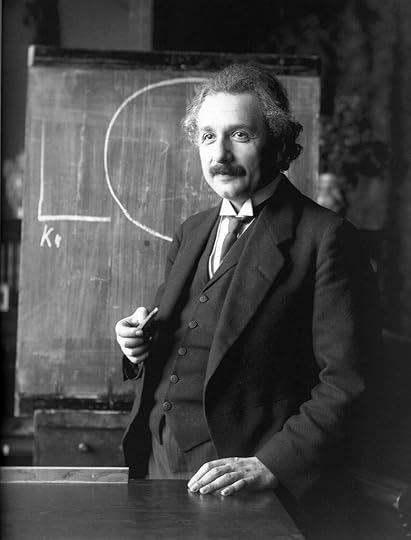
Photo by Ferdinand Schmutzer, Public domain, via Wikimedia Commons
The FBI watched him so closely that their report is over 1,400 pages long!Though Einstein’s scientific brilliance would surely have been a tremendous asset for any government, J. Edgar Hoover’s FBI was incredibly wary of him. In his personal life, the scientist’s support for social causes led to the bureau to keep tabs on him starting in December of 1932.
Believed to be a communist or a radical, as well as dedicated to speaking out against social injustice, he was deemed dangerous by the FBI, who kept tabs on Einstein. So extensive was their report, it went on for more than 1,400 pages!
Einstein had a mysterious daughter whose fate remains unknown.Though Einstein lived a fascinating, quirky, and brilliantly eccentric life, he is perhaps not the most mysterious member of his family. His first daughter, to whom Mileva Marić gave birth prior to the pair’s marriage, seems to have been forgotten by history.
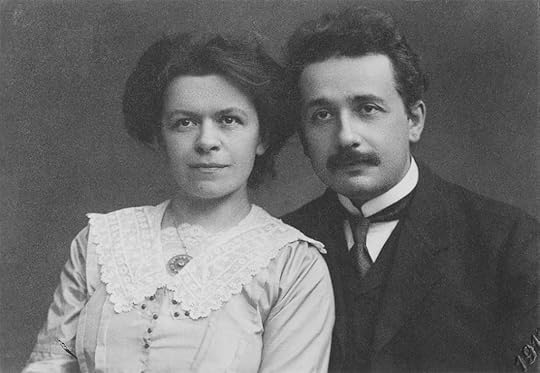
Albert and Mileva Marić Einstein, 1912
Beyond her name, Lieserl, and the fact she was born in January 1902 in Serbia, nothing is really known of this girl. She is believed to have died of scarlet fever before her second birthday, though little detail beyond that can be gleaned by Einstein’s letters which were discovered in the 1980s.
Albert Einstein was a skilled violin and piano player.Einstein may have been no great shakes at sailing, but he truly excelled at another of his favorite pastimes: playing music.
Before his sixth birthday, he was engaged in violin lessons. Sadly, he didn’t show the dedication and application required to learn an instrument – an attitude that would later be reflected in his school studies – but is said to have been inspired by the work of Mozart while in his teens. After that, he continued to find time to play when he could, even after becoming a world-renowned scientist.
Einstein’s brain is on display at the Mutter Museum in Philadelphia, Pennsylvania.When it comes to the finest minds in human history, one question everyone wants the answer to is how does the brain of a genius differ from everybody else’s? What do they have that we don’t? While the issues involved are never as simple as all of that, one thing’s for sure: Einstein’s brain attracted a huge amount of attention after his death.
The great scientist’s brain was stolen by one Thomas Harvey, who kept it in a laboratory in Philadelphia for a time. After this, it found a home in Princeton Hospital. Some inconclusive tests were performed on it, and it’s still in Philadelphia today, in the Mutter Museum.
Albert Einstein was offered the position of President of Israel.Needless to say, a man of Einstein’s renown commanded a tremendous amount of respect around the world. So much so that, in 1952, he was formally asked to be the second president of Israel!
Upon the death of Chaim Weizmann, the first holder of the position, the offer was extended, despite the fact that Einstein was not a citizen of the country. He solemnly refused, stating that he was flattered, but wasn’t qualified to hold the position and deal with people in an official capacity.
He developed an idea for an electricity-free refrigerator!Perhaps his time at the patent office also gave Einstein a proclivity for wacky ideas. Perhaps it was just his marvelous mind at work. Whatever the case, one of his most incredible ideas was his electricity-free refrigerator!
He worked on his design with a protégé of his, Leo Szilard, after hearing the tragic tale of a family killed when their broken refrigerator emitted dangerous gases. Einstein’s “absorption refrigerator” used no Freons, was healthier for the environment than contemporary models, and even had the potential to run via solar power!
Einstein had a strong aversion to socks and refused to wear them!As wise, respected, and brilliant as Einstein was, his creative side came hand in hand with a certain eccentricity. His trademark wild hair is familiar to everyone, but few know of his utter contempt for socks!
As a child, Einstein suffered the entirely relatable discomfort of his socks developing holes and his toes poking through them. Considering it far easier to simply dispense with them, he continued to do so for the rest of his life. He is seen without socks in many photographs, and even refused to wear any when he met President Franklin Delano Roosevelt at the White House!
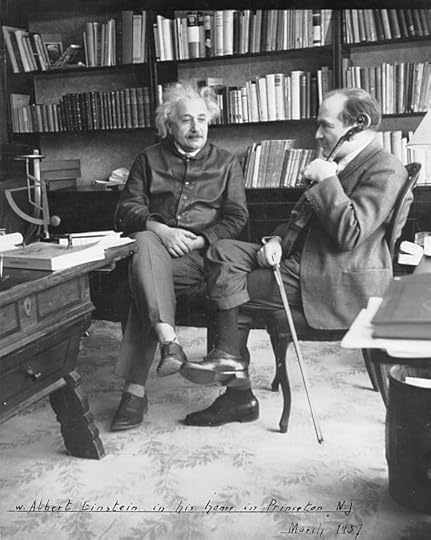
Albert Einstein in his N.J. apartment with violinist Bronislaw Huberman, March 1937. The B. Huberman Archive || Photo by באדיבות של עירית שיינהורן – מנהלת הספריה המוסיקלית Pikiwiki Israel, CC BY 2.5
Einstein’s IQ remains a mystery.The mind of a genius is always going to attract fascination and scientific research. For the very same reason, Einstein’s Intelligence Quotient has been the subject of great debate.
Though many sources claim to offer a definitive number (160 is a popular one), the truth is that the man himself is not known to have taken any such test in his lifetime. Even if he had, there’s no saying whether his IQ would have been extraordinary. After all, such tests offer a general idea of one concept of intelligence. Though he was a titan of the physics world, there’s no reason why he would have greatly excelled elsewhere.
He won his Nobel Prize in physics one century ago!Though the Theory of Relativity is Einstein’s best-known achievement in the field of physics, it’s a curious fact that he didn’t win his Nobel Prize for it.
Instead, he won the Nobel Prize in Physics 1921 “for his services to Theoretical Physics, and especially for his discovery of the law of the photoelectric effect.” This lesser-known discovery of Einstein’s governs the way that electric sparks are given off by metal electrodes when exposed to light waves of a certain frequency. He would actually be awarded the prestigious prize the following year.
Einstein refused the surgery that may have saved his life.Over the course of his distinguished career, Einstein changed the course of science forever and cemented his place in history. It’s no surprise, then, that when he knew his end was coming, he was satisfied with everything he had achieved.
On April 18, 1955, at the age of 76, Einstein found himself in a hospital in Princeton, New Jersey, with a ruptured blood vessel. His life could perhaps have been saved, but he refused any treatment or procedure. He stoically declared, “It is tasteless to prolong life artificially. I have done my share; it is time to go. I will do it elegantly.” Soon afterward, he did exactly that.
By Chris Littlechild, contributor for Ripleys.com
EXPLORE THE ODD IN PERSON! Discover hundreds of strange and unusual artifacts and get hands-on with unbelievable interactives when you visit a Ripley’s Odditorium!CARTOON 03-14-2022
March 13, 2022
CARTOON 03-13-2022
Ripley Entertainment Inc.'s Blog
- Ripley Entertainment Inc.'s profile
- 52 followers




